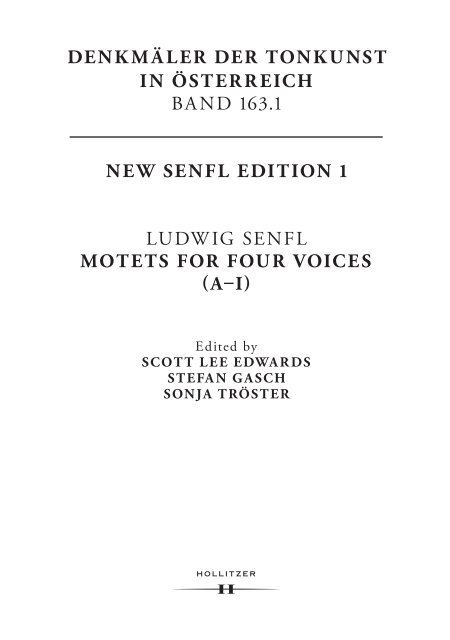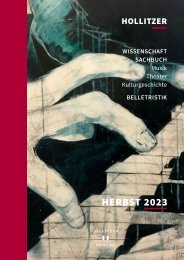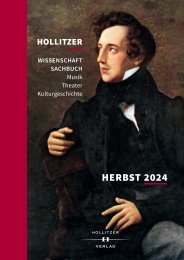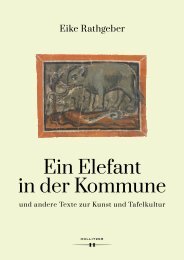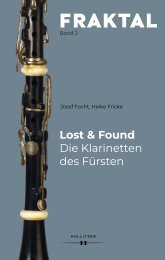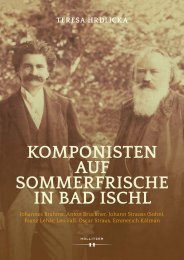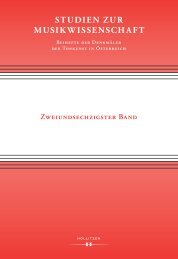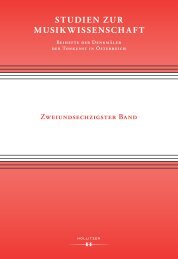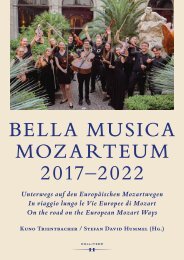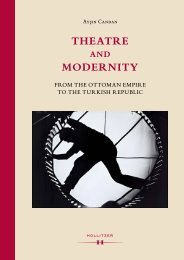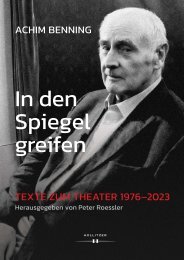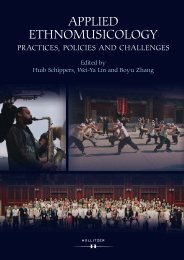Create successful ePaper yourself
Turn your PDF publications into a flip-book with our unique Google optimized e-Paper software.
DENKMÄLER DER TONKUNST<br />
IN ÖSTERREICH<br />
BAND <strong>163.1</strong><br />
NEW SENFL EDITION 1<br />
LUDWIG SENFL<br />
MOTETS FOR FOUR VOICES<br />
(A–I)<br />
Edited by<br />
SCOTT LEE EDWARDS<br />
STEFAN GASCH<br />
SONJA TRÖSTER
<strong>DTÖ</strong> <strong>163.1</strong>
PUBLIKATIONEN DER GESELLSCHAFT<br />
ZUR HERAUSGABE DER<br />
DENKMÄLER DER TONKUNST<br />
IN ÖSTERREICH<br />
begründet von<br />
GUIDO ADLER<br />
unter Leitung von<br />
MARTIN EYBL<br />
und<br />
BIRGIT LODES<br />
BAND 163<br />
NEW SENFL EDITON<br />
<strong>DTÖ</strong> <strong>163.1</strong>
DENKMÄLER DER TONKUNST<br />
IN ÖSTERREICH<br />
BAND <strong>163.1</strong><br />
NEW SENFL EDITION 1<br />
LUDWIG SENFL<br />
MOTETTEN FÜR VIER STIMMEN<br />
(A–I)<br />
Herausgegeben von<br />
SCOTT LEE EDWARDS<br />
STEFAN GASCH<br />
SONJA TRÖSTER
DENKMÄLER DER TONKUNST<br />
IN ÖSTERREICH<br />
VOLUME <strong>163.1</strong><br />
NEW SENFL EDITION 1<br />
LUDWIG SENFL<br />
MOTETS FOR FOUR VOICES<br />
(A–I)<br />
Edited by<br />
SCOTT LEE EDWARDS<br />
STEFAN GASCH<br />
SONJA TRÖSTER<br />
<strong>DTÖ</strong> <strong>163.1</strong>
Dieser Band wird an die beitragenden Mitglieder<br />
der Gesellschaft zur Herausgabe von Denkmälern der Tonkunst in Österreich (Subskribenten)<br />
zu wesentlich ermäßigtem Preis abgegeben.<br />
Bei Aufführungen der in diesem Band veröffentlichten Werke sind<br />
die Denkmäler der Tonkunst in Österreich als Quelle auf Programmen, in Ansagen usw. zu nennen.<br />
Veröffentlicht mit Unterstützung des<br />
Austrian Science Fund (FWF):<br />
PUB 713-G<br />
(Forschungsergebnisse des FWF-Projektes P 27469)<br />
Leitung: Stefan Gasch<br />
Open Access: Wo nicht anders festgehalten, ist diese Publikation<br />
lizenziert unter der Creative-Commons-Lizenz Namensnennung 4.0;<br />
siehe http://creativecommons.org/licenses/by/4.0/<br />
Satz: Gabriel Fischer<br />
Notensatz: Alexander J. Eberhard, Scott Lee Edwards, Stefan Gasch, Sonja Tröster<br />
Hergestellt in der EU<br />
© 2021 by HOLLITZER Verlag, Wien<br />
ISMN 979-0-50270-019-5<br />
ISBN 978-3-99012-801-5<br />
ISSN 2616-8987
TABLE OF CONTENTS<br />
GENERAL INTRODUCTION<br />
AND ACKNOWLEDGEMENTS ................................... IX<br />
INTRODUCTION .............................................................. XI<br />
PLATES .............................................................................. XXIX<br />
1. A subitanea et improvisa morte ...................................... 1<br />
2. Assumpta est Maria in caelum ........................................ 3<br />
3. Quinque Salutationes Domini Nostri Jesu Christi<br />
Salutatio prima: Ave, Domine Jesu Christe,<br />
Rex benedicte, Verbum Patris .................................. 5<br />
Salutatio secunda: Ave, Domine Jesu Christe,<br />
Rex benedicte, Laus Angelorum ............................. 7<br />
Salutatio tertia: Ave, Domine Jesu Christe,<br />
Rex benedicte, Lumen caeli ..................................... 9<br />
Salutatio quarta: Ave, Domine Jesu Christe,<br />
Rex benedicte, Splendor Patris .............................. 11<br />
Salutatio quinta: Ave, Domine Jesu Christe,<br />
Rex benedicte, Vita dulcis ...................................... 13<br />
4. *Ave, sanctissima Maria .................................................. 17<br />
2.p. Tu es singularis Virgo pura .................................... 19<br />
3.p. Ora pro nobis Jesum ................................................ 22<br />
4.p. Tuum dilectum filium ............................................ 23<br />
5. Beati omnes qui timent Dominum (i) ......................... 24<br />
2.p. Filii tui sicut novellae olivarum ............................ 27<br />
6. Beati omnes qui timent Dominum (ii) ....................... 30<br />
2.p. Benedicat tibi Dominus ex Sion ........................... 33<br />
7. Christe, qui lux es ............................................................ 34<br />
8. *Collegerunt pontifices ........................................... 42<br />
2.p. Unus autem ex ipsis .......................................... 46<br />
9. Completi sunt dies Mariae ...................................... 49<br />
10. Cum aegrotasset Job ............................................... 51<br />
2.p. Videte, omnes populi ....................................... 54<br />
11. Da pacem, Domine (i) ............................................ 56<br />
14. Deus, in adiutorium meum intende ............................ 64<br />
2.p. Exultent et laetentur ................................................ 67<br />
15. *Dies est laetitiae ............................................................. 70<br />
16. Dum steteritis ante reges ................................................ 72<br />
17. Ecce concipies et paries filium ...................................... 74<br />
2.p. Hic erit magnus ........................................................ 77<br />
18. Ecce Maria genuit nobis Salvatorem (i) ...................... 79<br />
19. Ecce Maria genuit nobis Salvatorem (ii) ..................... 82<br />
20. Ecce quam bonum ........................................................... 84<br />
2.p. Quoniam illic mandavit Dominus ....................... 90<br />
21. Egregie Dei martyr, Sebastiane .................................... 96<br />
22. Festum nunc celebre ..................................................... 100<br />
23. Gaude, Dei Genitrix ..................................................... 111<br />
2.p. Virgo, tu sola ........................................................... 115<br />
24. Hic accipiet benedictionem ......................................... 117<br />
25. In exitu Israel de Aegypto (i) ....................................... 120<br />
26. *In exitu Israel de Aegypto (ii) .................................... 130<br />
CRITICAL APPARATUS<br />
Editorial Conventions .......................................................... 153<br />
General and Bibliographical Abbreviations ..................... 157<br />
RISM Sigla of Libraries ....................................................... 158<br />
Sources .................................................................................... 159<br />
Bibliography ........................................................................... 165<br />
Critical Reports ..................................................................... 171<br />
Alphabetical Index of Text Incipits ................................... 225<br />
12. De profundis clamavi (i) ................................................ 59<br />
13. Descendi in hortum nucum (i) ..................................... 61<br />
<strong>DTÖ</strong> <strong>163.1</strong>
IX<br />
GENERAL INTRODUCTION<br />
AND ACKNOWLEDGEMENTS<br />
Ludwig Senfl (c.1490–1543) can be regarded as a leading figure<br />
in the world of German-speaking composers between<br />
Heinrich Isaac and Orlando di Lasso as well as a European<br />
composer of the first rank, standing alongside such<br />
renowned contemporaries as Costanzo Festa, Philippe<br />
Verdelot, Nicolas Gombert, and Adrian Willaert. His extensive<br />
œuvre encompasses a broad range of vocal genres of<br />
the time and was composed in the course of his employment<br />
at two of the most important courts of the early sixteenth<br />
century: at the court of Emperor Maximilian I he<br />
launched his career as a singer and composer, and from 1523<br />
on he worked as court composer for Duke Wilhelm IV of<br />
Bavaria. At Wilhelm’s request, Senfl built the Munich Hofkapelle<br />
into a professional ensemble modelled, in regard to<br />
repertoire and organisation, on the imperial chapel.<br />
Senfl’s significance was already recognised in the nineteenth<br />
century, yet two efforts to publish his works in a<br />
modern edition were prematurely discontinued. These editions<br />
therefore provide only a fraction of Senfl’s overall<br />
compositional production and have resulted in the scholarly<br />
neglect of his œuvre, especially his motets. A new and complete<br />
edition of his works has been a desideratum for many<br />
years, a gap that the New Senfl Edition seeks to fulfil.<br />
Critical preliminary work for a complete edition of<br />
Senfl’s compositions involved the compilation of a catalogue<br />
raisonné, an undertaking realised through the generous<br />
funding of the Austrian Science Fund (FWF) between 2008<br />
and 2014 under the direction of Birgit Lodes. This publication<br />
(herein referred to as the Senfl Catalogue or SC) provides<br />
an essential foundation for the documentation of<br />
works and sources in the New Senfl Edition.<br />
The edition of the motets, which forms the beginning<br />
of the collected works, will be presented in four volumes, in<br />
which the compositions are organised according to scoring<br />
and alphabetical order. Six pieces conceived as pure canons<br />
conclude the final volume of motets.<br />
Vol. 1: 26 motets à 4 (A–I)<br />
Vol. 2: 29 motets à 4 (N–V) + 1 Fragment<br />
Vol. 3: 31 motets à 5<br />
Vol. 4: 15 motets à 6; 3 motets à 8; 6 canons<br />
***<br />
The editors of the edition owe thanks to many colleagues<br />
and institutions for their help and support. Without the<br />
Austrian Science Fund (FWF), which provided generous<br />
financial assistance (P 27469), the work of the edition would<br />
not have been possible. The Department of Musicology at<br />
the University of Vienna (Birgit Lodes) and the Department<br />
of Musicology and Performance Studies at the University<br />
of Music and Performing Arts Vienna (Nikolaus<br />
Urbanek) cordially hosted the project within their premises.<br />
We also would like to express our thanks to the many<br />
libraries and archives that provided reproductions of sources<br />
for Senfl’s music. Especially important to mention are<br />
the following institutions, whose personnel greatly facilitated<br />
the work of the edition through their kind and ready<br />
responses to our inquiries:<br />
Dresden, Sächsische Landesbibliothek –<br />
Staats- und Universitätsbibliothek Dresden, SLUB<br />
(Christine Sawatzki, Andrea Hammes)<br />
Hradec Králové, Muzeum východních Čech<br />
v Hradci Králové (Jaroslava Pospíšilová)<br />
Klosterneuburg, Augustiner-Chorherrenstift,<br />
Bibliothek (Martin Haltrich)<br />
Melk, Benediktinerstift, Stiftsbibliothek und<br />
Musikarchiv (Bernadette Kalteis)<br />
München, Bayerische Staatsbibliothek<br />
(Veronika Giglberger, Bernhard Lutz)<br />
Regensburg, Bischöfliche Zentralbibliothek,<br />
Proskesche Musikabteilung (Raymond Dittrich)<br />
Stuttgart, Württembergische Landesbibliothek<br />
(Arietta Ruß)<br />
Wien, Österreichische Nationalbibliothek<br />
(Thomas Leibnitz)<br />
Wien, Fachbereichsbibliothek Musikwissenschaft,<br />
Universitätsbibliothek Wien (Benedikt Lodes)<br />
Zwickau, Ratsschulbibliothek (Gregor Hermann)<br />
<strong>DTÖ</strong> <strong>163.1</strong>
X<br />
As head of publications for the Denkmäler der Tonkunst in<br />
Österreich, Martin Eybl has placed his trust in our work,<br />
accompanied the creation of the edition from its initial<br />
stages, and most graciously accepted the volumes for publication<br />
in the <strong>DTÖ</strong> series.<br />
We have repeatedly received constructive feedback on<br />
our work through various academic exchanges that have<br />
proven invaluable for the advancement and development of<br />
the edition. Intensive discussions on editorial approaches,<br />
issues, and guidelines were held with our advisory board, in<br />
which Bonnie Blackburn, David Burn, Bernhold Schmid<br />
alongside Andrea Lindmayr-Brandl and Birgit Lodes as representatives<br />
of the editorial board of the <strong>DTÖ</strong> participated<br />
and generously gave their time. We thank them for always<br />
lending an open ear to our questions.<br />
We were also afforded opportunities to examine the<br />
work of the edition more closely through two workshops:<br />
Jan Bilwachs, Marc Busnel, Martin Eybl, Oliver Korte,<br />
Friedrich Neubarth, and Annerose Tartler took the trouble<br />
to reconstruct fragmentary motets; Grantley McDonald,<br />
Irene Holzer, Bernhold Schmid, and Thomas Schmidt<br />
provided new insights as they addressed questions of text<br />
setting and text underlay in sources transmitting Senfl’s<br />
motets.<br />
We also received generous help on a more individual<br />
level. Lenka Hlávková, Ton Oliveira, and Mateusz Zimny<br />
assisted us in gaining access to sources in the Czech Republic<br />
and Poland. Bonnie Blackburn and Leo franc Holford-<br />
Strevens provided invaluable help in linguistic and formal<br />
corrections of the volumes, and Joshua Rifkin provided<br />
critical editorial feedback in the early stages of the edition.<br />
Sabine Ladislav was always willing to assist in organising<br />
workshops and meetings, and without the technical and<br />
creative inclinations of Imke Oldewurtel, the edition would<br />
not be enhanced by clefs modelled on sixteenth-century<br />
sources.<br />
Just as importantly, the enthusiastic members of the<br />
New Senfl Choir and the ensemble Stimmwerck critically<br />
evaluated and tested our editions through numerous rehearsals<br />
and performances.<br />
To the countless colleagues and institutions not already<br />
mentioned we also extend thanks, and last but not least to<br />
the Hollitzer Wissenschaftsverlag: Alexander Eberhard<br />
kindly took care of the proof-reading, copy editing, and the<br />
preparation of the final print templates; Gabriel Fischer<br />
provided an elegant layout and patiently included all our<br />
corrections; Michael Hüttler and Sigrun Müller supported<br />
the printing of the volumes with great enthusiasm and readily<br />
agreed to the funding strategy of the FWF by publishing<br />
both in traditional printed and future-oriented open access<br />
formats.<br />
The Editors Vienna, May 2021<br />
<strong>DTÖ</strong> <strong>163.1</strong>
XI<br />
INTRODUCTION<br />
SCATTERED IN HISTORY: ON THE HISTORICAL BACKGROUND OF THE<br />
NEW EDITION OF THE COLLECTED WORKS OF LUDWIG SENFL<br />
The New Senfl Edition (NSE) opens with two volumes<br />
bringing together all the extant four-voice motets attributed<br />
to Ludwig Senfl. With these volumes, it is now possible to<br />
address a gap in research that has persisted since the beginning<br />
of the twentieth century and resulted in the neglect of<br />
Senfl as a ‘motet composer’. The need for a complete edition<br />
of the motets of Senfl, a key figure in the Central European<br />
musical world between the time of Heinrich Isaac and Orlando<br />
di Lasso, was affirmed already in 1903 by Theodor<br />
Kroyer:<br />
Als nächste dringliche Aufgabe […] erschien die<br />
Rehabilitierung des Kirchenkomponisten, und<br />
zwar deshalb, weil man eben bisher über den<br />
Lieder komponisten den Motettenmeister fast ganz<br />
übersehen hatte, trotzdem das 16. Jahrhundert<br />
diesen letzteren sogar noch höher schätzte.1<br />
In the inaugural (and only) volume of his unfinished edition<br />
of Senfl’s music for the series Denkmäler der Tonkunst<br />
in Bayern, Kroyer described the current state of research of<br />
his time, in which a strong interest in Senfl’s lieder contrasted<br />
with a relative lack of interest in Senfl’s (para-)liturgical<br />
works.2 The concept for a complete edition of Senfl’s works,<br />
as laid out by Kroyer in the introduction (see Figure 1,<br />
p. XII), was intended to address this one-sided perspective:<br />
Senfl’s Magnificat settings along with motets and motet-like<br />
compositions with Latin texts were to form the beginning<br />
of an edition, with the latter two being subdivided into ‘allgemeine’<br />
and ‘besondere’ works.3 These were to be followed<br />
by the Psalmodia octo tonorum,4 the masses, and finally the<br />
compositions with German texts (divided into sacred and<br />
secular lieder) along with Senfl’s ode settings. A volume of<br />
1 ‘As the next urgent task […] the rehabilitation of the church<br />
composer seemed necessary. Although the sixteenth century estimated<br />
the master of motets higher than the composer of lieder,<br />
the first has been hitherto almost entirely forgotten.’ DTB iii/2:<br />
X. (For detailed information on the literature used, see the Bibliography<br />
to this volume on pp. 165–70.)<br />
2 Many handwritten transcriptions of Senfl’s motets from the<br />
nineteenth and early twentieth centuries kept in libraries all over<br />
Europe, however, bear witness to the lively interest in these compositions.<br />
3 DTB iii/2: XI.<br />
4 It cannot be determined what exactly Kroyer meant when he<br />
mentions the Psalmodia. In the SC, Senfl has been identified as<br />
the composer of three cycles of Psalmodia, composed of polyphonic<br />
recitation models in simple counterpoint for everyday<br />
liturgical use (see SC P 121–3).<br />
varia and supplements, in which Kroyer included Senfl’s additions<br />
to Heinrich Isaac’s Choralis Constantinus, canons,<br />
exempla from music theory treatises, French and Italian<br />
pieces as well as doubtfully attributed works, was to complete<br />
the edition. Kroyer published the first volume of Magnificat<br />
settings and ‘general’ motets, but the rest of the edition<br />
was never realised.<br />
The next attempt to publish the complete works was the<br />
edition Ludwig Senfl: Sämtliche Werke (SW), of which eleven<br />
volumes, edited by the Staatliche Institut für deutsche<br />
Musikforschung in conjunction with the Schweizerische<br />
Musikforschende Gesellschaft, were published from 1937 to<br />
1974. While the first four volumes were initially published<br />
as part of the Reichsdenkmale of the series Erbe der<br />
deutschen Musik (vols. 5 [= SW 1] and 10 [= SW 2] were<br />
published in 1937; vol. 13 [= SW 3] in 1939; and vol. 15<br />
[= SW 4] in 1940), the Schweizerische Musikforschende Gesellschaft<br />
and the Schweizerische Tonkünstler verein issued<br />
the remaining volumes — together with reprints of those<br />
already published — as an independent complete edition.<br />
But this edition, too, was interrupted after the publication<br />
of the ‘Liturgische und allgemein-geist liche Motetten I’<br />
(SW 11) and thus made available only twenty-seven of a total<br />
number of 104 extant motets. Other isolated motets were<br />
published in the context of source editions such as Georg<br />
Rhau: Musikdrucke aus den Jahren 1538–15455 and Die Handschrift<br />
des Jodocus Schal reuter,6 two volumes by Henrik<br />
Glahn,7 or Ole Kongsted’s single-volume Motets by Ludwig<br />
Senfl.8 These publications, however, still did not provide a<br />
coherent overview of Senfl’s motet œuvre due to the differing<br />
types of editions and editorial techniques.<br />
At the same time, it was apparent that new research on<br />
Senfl would be impeded without a proper list of works.<br />
Thanks to a detailed examination of Senfl’s overall œuvre<br />
undertaken in compiling his catalogue raisonné (hereafter<br />
SC), the New Senfl Edition can now be based on the most<br />
up-to-date research. In the SC, all known sources for every<br />
individual work were compiled, and in this process many<br />
new insights were gained. The discovery of new concordant<br />
sources, including the (tentative) identification of anonymously<br />
transmitted works, often put into question existing<br />
assumptions, and completion of the catalogue offered the<br />
first chance to place individual works in the context of his<br />
œuvre. New source evaluations relative to older editions<br />
5 Rhau vi, Rhau viii, Rhau x, Rhau xi, Rhau xii.<br />
6 EdM 115/116.<br />
7 Glahn 1978; Glahn 1986.<br />
8 Kongsted 2001.<br />
<strong>DTÖ</strong> <strong>163.1</strong>
XII<br />
Figure 1. Theodor Kroyer’s concept for a collected edition of the works by Ludwig Senfl<br />
in DTB iii/2: XI.<br />
were made that led to revaluations of the transmission of<br />
individual works, information on which the selection of<br />
principal sources for the motets in the present edition is<br />
based.<br />
Senfl’s settings of sacred Latin texts pose an additional<br />
problem of classification: in both fragmentary editions, his<br />
settings of the mass proper were not differentiated from his<br />
motets. It is clear, however, that the repertoire Senfl composed<br />
for the mass proper forms an independent and comprehensive<br />
core of his overall compositional œuvre that<br />
should be distinguished from his motet output, while at the<br />
same time, it is apparent that boundaries between these<br />
genres were fluid in the sixteenth century, and firm generic<br />
divisions do not always apply.9 Compositions had variable<br />
functions and moved loosely between the boundaries of<br />
genres, despite modern attempts to classify works in single<br />
categories of genre. The organisation of works in the NSE<br />
now follows decisions on classification made in the course<br />
of preparing the SC.<br />
In comparison to earlier editions, the NSE offers<br />
numerous advantages. The repertoire to be edited — in the<br />
present case, the four-voice motets — is presented for the<br />
first time in its entirety. It is organised systematically according<br />
to number of voices and alphabetically, and the<br />
transcriptions, structure of the edition, and critical apparatus<br />
are conceived according to uniform, up-to-date editorial<br />
guidelines (see the section ‘Editorial Conventions’). Works<br />
whose authorship remains uncertain have been included in<br />
the edition along with works that survive in fragmentary<br />
form, whereas works that are unequivocally misattributed<br />
to Senfl have been excluded. In cases where compositions<br />
exist in more than one clearly discernible version (such as<br />
the four- and five-voice versions of Nisi Dominus), each<br />
version is transcribed and evaluated in the respective volumes<br />
of the edition.<br />
It is the editors’ hope that the fruits of this work and the<br />
comprehensiveness of the edition will serve both as an encouragement<br />
to musicians who wish to explore this diverse<br />
repertoire, and as a springboard for scholars in the production<br />
of new research.<br />
9 For example, the polyphonic sequence Grates nunc omnes<br />
(SC P 5c) must have been sung within the liturgical framework of<br />
the first mass on Christmas day. Nevertheless, the setting became<br />
one of Senfl’s most widely disseminated, independent liturgical<br />
compositions, one that circulated in sixteenth-century anthologies<br />
of motets. Likewise, determinations as to whether and<br />
when antiphon settings, hymns, or responsorial motets were<br />
performed liturgically — the latter group often included in<br />
sources prepared for use in religious services — are often difficult<br />
to make.<br />
<strong>DTÖ</strong> <strong>163.1</strong>
XIII<br />
GETTING TO KNOW LUDWIG SENFL: THE MOTETS FOR FOUR VOICES<br />
Senfl Among His Contemporaries<br />
Now that the entire corpus of surviving four-voice motets of<br />
Ludwig Senfl can be presented, we at last have the opportunity<br />
to begin properly assessing Senfl’s role in the development,<br />
promotion, and transmission of the motet. As a member<br />
of royal music chapels, as composer and as editor, Senfl<br />
can be seen as a figure of transition from the late medieval<br />
period to the sixteenth century, with the profound changes<br />
in the media of musical distribution and religious reform<br />
that accompanied this period. In few other genres can this<br />
transition be seen so clearly as in his approach to the motet.<br />
While some aspects of his motet corpus are clearly rooted in<br />
the musical environment of the imperial chapel of Emperor<br />
Maximilian I, other aspects of his work conform with the<br />
musical output of his contemporaries abroad. As with<br />
Pierre de la Rue, Josquin Desprez, and other composers at<br />
the start of the sixteenth century, four-voice compositions<br />
form the core of Senfl’s extant motet œuvre (55 à 4; 31 à 5; 15<br />
à 6; 3 à 8);10 and like other composers of his own generation,<br />
including Adrian Willaert, Nicolas Gombert, or Jacobus<br />
Clemens non Papa, Senfl devoted much more attention to<br />
the writing of motets (of 118 documented motets, 104 are<br />
extant in addition to one fragment) than he did to mass<br />
ordinary settings (10),11 which stands in direct contrast to<br />
the output of composers at the end of the fifteenth century.<br />
From a technical point of view, Senfl adapted the precedents<br />
set by Heinrich Isaac, who, as court composer of<br />
the imperial chapel, served as Senfl’s teacher, and by Josquin,<br />
whose music Senfl viewed as a compositional benchmark.<br />
What he had learned from Isaac and Josquin, however, he<br />
turned into a lifelong creative pursuit by continuing to experiment<br />
with latent possibilities in the traditional cantus<br />
firmus motet and through his contributions to the modern<br />
genre of psalm motets. In his engagement with these motet<br />
forms, Senfl distinguished himself from his contemporaries<br />
and, as a result, left behind a body of work that enriches our<br />
understanding of the variety of motet practices cultivated<br />
and performed throughout the sixteenth century in a geographic<br />
expanse stretching across Central Europe.<br />
Senfl’s style in motet composition stems in part from<br />
his lifelong engagement in composing and performing music<br />
for the liturgy. Unlike Josquin, Willaert, Gombert, and<br />
10 Along with such ‘post-Josquin’ contemporaries as Adrian<br />
Willaert, Philippe Verdelot, and Jacquet of Mantua, Senfl increasingly<br />
turned his attention to five-voice composition and<br />
helped establish its equal footing with four-voice composition by<br />
the end of his life. For a detailed assessment of the five-voice<br />
motets, see the introduction to NSE 3.<br />
11 Another reason for the small number of mass ordinaries is the<br />
fact that Senfl himself had incorporated many ordinary settings<br />
from the repertoire of the dissolved chapel of Maximilian I into<br />
that of the Munich court chapel. Together with several other<br />
polyphonic ordinary settings which were already available when<br />
Senfl was hired in Munich in 1523, there was simply no need to<br />
provide more settings. Wilhelm IV, Duke of Bavaria, rather<br />
focused on music for (personal) devotion.<br />
Clemens non Papa, whose contributions to liturgical genres<br />
are comparatively slight, Senfl — not least in order to meet<br />
the requirements of his position at the Bavarian court — continued<br />
to compose liturgical music throughout his career,<br />
above all mass proper cycles. In doing so, he brought liturgical<br />
compositions and para-liturgical motets compositionally<br />
and functionally closer to one another, a tightened relationship<br />
that is especially evident in his frequent setting of<br />
antiphon melodies.12 Although he did not limit himself to<br />
the polyphonic treatment of plainchant, having also set<br />
psalms, humanist poetry, and other non-liturgical texts, the<br />
majority of Senfl’s motets are elaborations of a pre-existing<br />
plainchant melody, a circumstance that points to the liturgical<br />
tradition in which he was deeply rooted, but also to<br />
the conceptual links joining his motets to his extensive<br />
work in mass proper composition and in revising and completing<br />
Isaac’s Choralis Constantinus.<br />
These compositional proclivities, coupled with Senfl’s<br />
unique position as the first ‘court composer’ of the ducal<br />
chapel in Munich, also encourage us to rethink music histories<br />
that view motet composition of the ‘post-Josquin era’<br />
as an emancipation from cantus firmus composition<br />
through the technique of pervasive imitation, as represented<br />
by such composers as Gombert.13 Thomas Crecquillon, for<br />
example, rarely composed cantus firmus motets, though occasionally<br />
a chant is either paraphrased or quoted. For<br />
Clemens non Papa, pervasive imitation is the rule and there<br />
is little use of canonic techniques. Senfl consistently turned<br />
to imitative techniques and his four-voice motets amply<br />
confirm that imitation and cantus firmus were not mutually<br />
exclusive but rather coexisted fruitfully alongside one<br />
another. He adapts the evaded cadences of Gombert or<br />
Willaert to cantus firmus composition in a contrapuntal<br />
style that is largely, but not strictly, free of caesuras. This<br />
amalgam of techniques continued to define the motet repertoire<br />
performed at the Munich court and enjoyed a<br />
broad public audience through the motet anthologies that<br />
brought the work of Senfl and so many of these other<br />
‘post-Josquin’ composers together.<br />
At the same time that Senfl builds on precedents in cantus<br />
firmus treatment set by Isaac and Josquin, he worked<br />
out different solutions in which the cantus firmi are hardly<br />
ever deployed as they had been in the traditional tenor<br />
motet. Voices surrounding the cantus firmus are almost<br />
always imbued with material from the cantus firmus, thus<br />
breaking down the lines between cantus firmus and imitation.<br />
He rarely composed motets with a purely ‘structural’<br />
cantus firmus, but rather preferred hybrid forms in which<br />
the pre-existent tune or tunes migrate among the other<br />
voices or are transformed in the chant-carrying voice. Even<br />
in his early tenor motets, Senfl does not adhere to a rigid<br />
presentation of the cantus firmus in long note values, but<br />
rather flexibly adapts the melody in a process of development<br />
12 Schmidt-Beste 2012: 273.<br />
13 Nugent/Jas 2001.<br />
<strong>DTÖ</strong> <strong>163.1</strong>
XIV<br />
as the motet unfolds: the melodies often undergo quickened<br />
elaboration at cadences as well as in the final phrases, such<br />
that they merge texturally with the other voices (e.g. Pange,<br />
lingua (i), SC M 80; NSE 2.36). In the four-voice motets<br />
featuring the plainchant in canon, Senfl often opts for a<br />
quasi-canonic treatment, in which the melody is sung with<br />
increasing flexibility (e.g. Assumpta est Maria, SC M 7; NSE<br />
1.2; and Completi sunt dies Mariae, SC M 18; NSE 1.9),<br />
demonstrating his greater regard for the sonorous results of<br />
musical transformation over the application of strict rules<br />
or traditions. Senfl’s compositional approach to motets can<br />
therefore be described as a style that freely integrates traditional<br />
resources and views composition less as a consistently<br />
applied solution to a difficult problem, than as a varied and<br />
sonorous presentation of musical materials.<br />
Like Jean Mouton and Adrian Willaert, Senfl adapted<br />
hallmarks of Josquin’s style in his motet compositions, especially<br />
his psalm motets, such as paired imitation, clear<br />
declamation, and a rhetorical approach to form. Many of<br />
Senfl’s motets are structured in a series of clauses initiated<br />
by a matching pair of imitative duos — either discantus and<br />
contratenor or tenor and bassus — with phrases concluding<br />
on a full-voiced cadence frequently overlapping with the beginning<br />
of the next clause. But in Senfl’s motets, paired imitation<br />
counts only as one available technique within a vast<br />
arsenal of approaches. He just as often opts for simultaneous<br />
entries of two voices followed in imitation by the other<br />
pair, stretto entries, unpaired four-part imitation, or homophonic<br />
openings that immediately unravel in polyphony.<br />
Imitation might proceed at the fourth, fifth, or octave, and<br />
these intervals might change across paired voices in instances<br />
of imitative duos. Senfl also frequently contrasts imitation<br />
with homophonic utterance, in contrast to Gombert,<br />
who tended to avoid imitative duos and relied on homophony<br />
only slightly. Moreover, Senfl did not limit his use of<br />
liturgical melodies to settings of Marian antiphons or tenor<br />
cantus firmus compositions, like the followers of Mouton,<br />
Gombert, or contemporary Spanish composers. This is an<br />
indication of the differing tradition of musical performance<br />
Senfl encountered and shaped at the Munich court.<br />
Indeed, representational requirements for the music<br />
chapels of Wilhelm IV and Duke Albrecht of Prussia as well<br />
as the aspirations of influential patrician families like the<br />
Fuggers shed some light on the corpus of texts Senfl set to<br />
music. Beyond the courts, his work circulated in Central<br />
Europe in a rich variety of sources alongside the gospel motets,<br />
arrangements of psalm verses, and responsorial motets<br />
in which other contemporaries such as Gombert or Clemens<br />
non Papa specialised, and thus his contributions to the repertoire<br />
can also be viewed as an essential response to the<br />
needs of a sixteenth-century society in the midst of extraordinary<br />
transformation. These needs were certainly varied,<br />
as the sources of Senfl’s motets document, and a larger view<br />
of Senfl’s overall motet corpus has much to reveal about the<br />
liturgical contextualisation of the sixteenth-century motet,<br />
the place of the motet in musical performance beyond the<br />
liturgy, and the intertextual-symbolic relations that such<br />
music channelled for Senfl’s diverse sixteenth-century audiences.<br />
A Constellation of Scribes, Printers, and Music<br />
Theorists: The Sources of Senfl’s Four-Voice Motets<br />
Senfl’s four-voice motets survive in sixty-seven manuscript<br />
sources and fourteen prints (including manuscript and<br />
printed tablatures for lute and keyboard). These sources<br />
were all compiled over the course of the sixteenth century<br />
and demonstrate the continued interest in Senfl’s music<br />
even long after his passing. The wide dispersion of these<br />
sources across the sixteenth-century German-speaking<br />
world, in addition to sources from Bohemia, Poland, and<br />
Upper Hungary, attests to Senfl’s reputation — as do the excerpts<br />
from his four-voice motets found in theoretical treatises<br />
by Heinrich Glarean (1547), Gallus Dressler (1561), Ambrosius<br />
Wilphlingseder (1563), and Ludovico Zacconi<br />
(1592).14<br />
Among manuscript sources, the Munich choirbooks are<br />
especially significant, since they provide valuable insight<br />
into the performance of these motets at the court where<br />
Senfl was employed. Senfl’s commitment to Josquin and his<br />
advocacy for the composer, for example, is evident in the<br />
compilation of the Munich choirbooks Mus.mss. 10 and 12,<br />
where Senfl’s motets are placed side-by-side with works by<br />
Josquin, the only two composers represented in these sources;<br />
it can be seen as well in the pride of place given to<br />
Josquin’s motets in the Liber selectarum cantionum (RISM<br />
15204).15<br />
Two sources that are especially comprehensive in their<br />
transmission of Senfl’s four-voice motets are D-Rp C 120, a<br />
choirbook known as the ‘Pernner Codex’, and D-Z 81/2, a<br />
set of partbooks of which three of the original four survive.<br />
D-Rp C 120 is a comprehensive manuscript anthology of<br />
some 100 motets, lieder, and chansons originating from the<br />
immediate environment of the imperial chapel. Compiled<br />
around 1518–21, the manuscript reflects the repertoire at the<br />
court of Emperor Maximilian I from the time during which<br />
Senfl presumably served in an unofficial capacity as music<br />
director of the court chapel. D-Z 81/2, in contrast, was<br />
copied between the 1530s and 1550s in Central Germany but<br />
includes, among its numerous works by Senfl, an extraordinary<br />
number of concordances with D-Rp C 120. Together,<br />
these manuscripts provide evidence that Senfl’s ‘early compositions’<br />
travelled across Germany even in his later years.<br />
Despite its later date of copying and origins removed from<br />
Senfl’s immediate environment, D-Z 81/2 consistently<br />
transmits fewer scribal errors, includes a reliable text underlay,<br />
and is more accurate in its titling of works, and thus<br />
more often serves as the principal source for motets in this<br />
edition. One such example is Descendi in hortum nucum (i)<br />
(SC M 30; NSE 1.13). In D-Rp C 120, this motet is titled<br />
Ascendo ad patrem meum, whereas D-Z 81/2 transmits the<br />
text from the Song of Songs corresponding to the cantus<br />
firmus in the tenor and paraphrased prominently in the<br />
14 For a complete overview over the dissemination of Senfl’s works,<br />
see SC 2.<br />
15 Schlagel 2002.<br />
<strong>DTÖ</strong> <strong>163.1</strong>
XV<br />
bassus (see Plates 11–14 and 30).16 Most likely, the differing<br />
title in the Pernner Codex resulted from a mix-up with the<br />
similar plainchant melody of the Ascension antiphon Ascendo<br />
ad Patrem meum (cf. Antiphonarium Augustense (1495),<br />
fol. 34 v ).17<br />
Other manuscript sources attesting to the important<br />
place accorded Senfl’s four-voice motets in Central-German<br />
repertoires are the ‘Eisenacher Cantorenbuch’ (D-EIa s.s.); a<br />
set of partbooks from the Thomasschule in Leipzig (D-LEu<br />
Thomaskirche 49/50); and the so-called ‘Walter-Handschriften’<br />
(D-GOl Chart. A 98, D-Ngm 83795 [T], D-Ngm 83795<br />
[B], D-WRhk MS B, PL-Kj Mus. ms. 40013, PL-Kj Mus.<br />
ms. 40043), the latter of which all originated in Torgau.<br />
Regarding printed sources, Senfl broke new ground<br />
through his involvement in assembling the first volume of<br />
motets printed in the German-speaking lands, the already<br />
mentioned folio choirbook Liber selectarum cantionum,<br />
issued in 1520 in Augsburg by Sigmund Grimm and Marx<br />
Wirsung and dedicated to Cardinal Matthäus Lang of<br />
Wellenburg, one of Maximilian’s most trusted advisers.18 In<br />
this book, which is organised according to number of voices<br />
(three sections of 6vv, 5vv, and 4vv motets), Senfl proudly<br />
presents his works (including three four-voice motets and<br />
the riddle canon Salve sancta parens among others) alongside<br />
compositions of the older generation, which includes<br />
Isaac, Josquin, Pierre de la Rue, Jacob Obrecht, and possibly<br />
Jean Mouton.19 This publication, however, proved to be an<br />
isolated event, for it was not, in fact, until 1537 that a second<br />
anthology of motets would be issued by a press in the German-speaking<br />
lands. This volume, Hans Ott’s Novum et<br />
insigne opus musicum (RISM 15371),20 not only includes<br />
thirteen compositions by Senfl (among them four four-voice<br />
motets),21 but also continued the system introduced in the<br />
Liber selectarum cantionum of ordering its contents according<br />
to scoring, a habit that would become standard practice<br />
by German presses for decades to follow (see Figure 2).22<br />
Ott devotes the opening and closing positions of each section<br />
to works by Josquin, whom he praises in his dedication<br />
to King Ferdinand I as ‘the most celebrated of this art’ (celeberrimu[m]<br />
huius artis). He also singles out Isaac in addition<br />
to Senfl, whom he describes as ‘easily the best contemporary<br />
composer’ of motets and to whom he suggests readers wanting<br />
more motets by Isaac should turn.23 The apparent commercial<br />
success of Ott’s anthology quickly reached the attention<br />
of other publishers: in 1538, both Johannes Petreius<br />
and Georg Rhau would enter the market with their first<br />
motet anthologies, followed by Peter Schöffer the Younger<br />
in Strasbourg the following year.24<br />
Although German printers did not begin to issue books<br />
of motets steadily until the final years of Senfl’s life, his<br />
four-voice motets continued to appear in anthologies issued<br />
from presses in Augsburg (Melchior Kriesstein; Philipp<br />
Ulhart), Frankfurt an der Oder (Johann Eichorn), Nuremberg<br />
(Johann vom Berg and Ulrich Neuber; Hieronymus<br />
Formschneider; Katharina Gerlach), and Wittenberg<br />
(Georg Rhau).25 These factors — the late entry into the<br />
market for polyphonic music by German printers and the<br />
greater cost of large anthologies — probably placed limitations<br />
on the international reach of Senfl’s motets: as John<br />
Kmetz has pointed out, printed German music did not typically<br />
travel far beyond German-speaking lands.26 The music<br />
of German composers did not in general tend to exceed<br />
these boundaries and Senfl’s music was no exception in this<br />
respect (see Figures 2a–c, pp. XVI–XVII).<br />
16 The ascription of the setting in D-Rp C 120 to Ludwig Senfl by<br />
Rainer Birkendorf (Birkendorf 1994, i: 72, 207; iii: 69–70), made<br />
without his knowledge of the concordance in D-Z 81/2, can thus<br />
be confirmed. The Zwickau partbooks also contain Senfl’s Egregie<br />
Dei martyr, Sebastiane (SC M 40; NSE 1.21), where sections of<br />
the cantus firmus appear in the discantus (in long note values)<br />
and the tenor (with various note values, embellishments, and free<br />
repetitions of sections); as well as the unusual A subitanea et improvisa<br />
morte (SC M 1; NSE 1.1) which sets a section from the<br />
Litany of Saints.<br />
17 A second Descendi in hortum (SC M 31) for five voices, cited three<br />
times in D-HEu Cod. Pal. germ. 318, is lost.<br />
18 It is clear that Senfl was involved in the preparation of this print<br />
to some extent. Recent research, however, has shown that it is not<br />
possible to determine his exact role in this printing project.<br />
Schiefelbein 2016.<br />
19 In the US-CA exemplar of RISM 1520 4 , Missus est Gabriel Angelus<br />
is ascribed to Mouton by Bernhard Rem, while in the D-Sl<br />
copy of this print the motet is ascribed to both Mouton and<br />
Josquin by an unknown scribe. The attribution to Mouton, however,<br />
remains in question.<br />
20 This volume, along with a second volume the following year<br />
(RISM 1538 3 ), was printed in Nuremberg by Hieronymus Formschneider.<br />
On the entire collection, see Gustavson 1998.<br />
21 Ott made the claim that the music in Novum et insigne opus<br />
musicum had never before appeared in print, although eight of<br />
the motets had already been issued in the Liber selectarum cantionum.<br />
Gustavson 1998, i: 210–11.<br />
22 German printers typically did not use the modal systems of<br />
organisation often found in Italian print anthologies. Lewis<br />
Hammond 2007: 36–7.<br />
23 ‘Et tamen si quis Isaaci plura etiam in hoc opere requirit, is habet<br />
quo animum suum expleat, nempe laudatissimas cantiones<br />
artificis nostra ætate facile in hoc genere primi, LVDOVICI<br />
SENFLII.’<br />
24 Neither volume printed in 1538 by Petreius — Tomus primus psalmorum<br />
selectorum (RISM 1538 6 ) and Modulationes aliquot quatuor<br />
vocum (RISM 1538 7 ) — contains music by Senfl, nor is Senfl’s<br />
music included in Schöffer’s Cantiones quinque vocum selectissimae<br />
(RISM 1539 8 ). Rhau’s Symphoniae iucundae (RISM 1538 8 ) and<br />
Selectae harmoniae (RISM 1538 1 ), on the other hand, include motets<br />
and mass proper settings by Senfl. Gustavson 2010: 207.<br />
25 In contrast to contemporary French and Italian publishers, German<br />
publishers typically printed repertoires that were far more<br />
international in scope and substantially larger in size: the average<br />
Venetian anthology of the mid-sixteenth century included only<br />
16–24 leaves per partbook, making it much smaller than a contemporary<br />
German anthology, which often exceeds 60 folios per<br />
partbook. Lewis Hammond 2007: 36.<br />
26 Kmetz 2010: 170.<br />
<strong>DTÖ</strong> <strong>163.1</strong>


